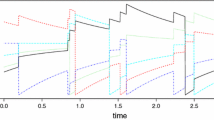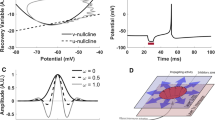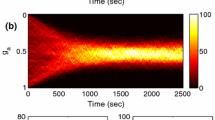Abstract
This paper studies the influence exerted by the presynaptic spike train on the postsynaptic one. It applies to synaptic exploration a novel method for characterization of point-process systems (Brillinger, 1974, 1975a), and draws from it physiologically meaningful conclusions. The departure point was a large data set of action potential trains from an Aplysia network whose neurons are connected by monosynaptic inhibitory or excitatory PSP's, and either discharged spontaneously or were driven by intracellular pulses. First, a sequence of “kernels” is estimated, each with a physiological connotation relevant to synaptic transmission. The kernel independent of time — of zero-order — measures the postsynaptic rate with no presynaptic discharge. That of a single time argument — of first-order — relates to the rate effect of the average PSP. Those of two, three, or more time arguments — of second, third or higher-order — relate to interactions between two, three, or more postsynaptic potentials (e.g. to facilitation) and/or spikes (e.g. to refractoriness). Then successive models are constructed recursively and based on the kernel of zero-order, on the kernels of zero and first order, on those of zero, first and second order, and so forth, until a desired approximation is achieved. The plausibilities of each kernel estimate and of each model are evaluated separately by way of spectra and coherences. The “linear” model based upon the zero and first-order kernel was tested (after that based exclusively on the zero-order one was proven inadequate). When presynaptic discharges are very irregular and at intermediate or low rates, it provides satisfactory description and prediction, and the first-order kernel is an uncontaminated display of the rate effects of the average presynaptic spike: this constitutes the “linear” domain. When presynaptic discharges are bursty, regular or very fast, the linear model is unsatisfyctory: this is referred to as “non-linear” domain. Reasons for non-linearity lie in PSP facilitation and anti-facilitation, conversion of membrane current into firing rate, after-spike excitability oscillations, and special pacemaker interactions. The model can be extended to three-neuron networks where partial coherences exract interactions between followers, even while submitted to a common driver. The basic and ubiquitous issues of spike train description and stability were discussed. The counting and the interval statistic of spike trains provide equivalent descriptions and their current opposition is conceptually meaningless. Concomitant short-term fluctuations in spike generation intensity at preand postsynaptic levels have funciional significance beyond changes in the overall average rate or interval: they are made precise by parameters whose definition, estimation and physiological interpretation are presented here. Some stability of the experimental preparation is presupposed by investigators, but variations (e.g. from cycles or deterioration) always exist. Hence, decisions as to the preparation's evolution and as to tolerable changes must be made, and based upon pre-existing knowledge, educated guesses and practical considerations. This study provided basic knowledge of the individual synapse considered the elementary building block of the nervous system when viewed as a network of interacting nerve cells. It also contributed generally applicable mathematical techniques which were illustrated by application to relatively well studied and simple networks.
Similar content being viewed by others
References
Astrom, K.J., Eykhoff, P.: System identification — a survey. Automatica 7, 123–162 (1971)
Brillinger, D.R.: Cross-spectral analysis of processes with stationary increments including the stationary G/G/queue. Ann. Probab. 2, 815–827 (1974)
Brillinger, D.R.: The identification of point process systems. Ann. Probab. 3, 909–924 (1975a)
Brillinger, D.R.: Statistical inference for stationary point processes. Stochastic processes and related topics, pp. 55–79, Ed.: Puri, M.L. New York: Academic 1975b
Brillinger, D.R.: Time series: data analysis and theory, New York: Holt, Reinhart and Winston 1975c
Bryant, H.L., Ruiz Marcos, A., Segundo, J.P.: Correlations of neuronal spike discharges produced by monosynaptic connections and by common inputs. J. Neurophysiol. 36, 205–225 (1973)
Cox, D.R., Lewis, P.A.W.: The statistical analysis of series of events. London: Methuen 1966
Efron, R.: Brology with consciousness and its consequences. Perspect. Biol. Med. 11, 9–36 (1967)
Granit, R., Kernell, D., La Marre, Y.: Synaptic stimulation superimposed on motoneurons firing in the “secondary range” to injected current. J. Physiol. (Lond.) 187, 407–415 (1966)
Griffith, J.S., Horn, G.: Functional coupling between cells in the visual cortex of the unrestrained cat. Nature (Lond.) 199, 893–895 (1963)
Knox, C.K.: Cross-correlation functions for a neuronal model. Biophys. J. 14, 567–582 (1974)
Knox, C.K., Poppele, R.E.: Response of neuronal systems to random pulse trains: theory and experimental results from Clarke's column neurons. Proceedings of the First Symposium on Testing and Identification of Non-linear Systems, pp. 227–236, McCann, G.D., Marmarelis, P.Z. (Eds.) California Institute of Technology, 1975
Krausz, H.: Identification of non-linear systems using random impulse train inputs. Biol. Cybernetics 19, 217–230 (1975)
La Salle, J.P., Lefschetz, S.: Stability by Liapunov's direct method with applications. New York: Academic Press 1961
Marmarelis, P., Naka, K.I.: Non-linear analysis and synthesis of receptivefield responses in the catfish retina. I. Horizontal cellganglion cell chains. J. Neurophysiol. 36, 605–618 (1973a)
Marmarelis, P.Z., Naka, K.I.: Non-linear analysis and synthesis of receptivefield responses in the catfish retina. II. One-input whitenoise analysis. J. Neurophysiol. 36, 619–633 (1973b)
Moore, G.P., Segundo, J.P., Perkel, D.H., Levitan, H.: Statistical signs of neuronal interactions. Biophys. J. 10, 876–900 (1970)
Nieman, R.E., Fisher, D.G., Seborg, D.E.: A review of process identification and parameter estimation techniques. Int. J. Contr. 13, 209–264 (1971)
O'Leary, D.P., Segundo, J.P., Vidal, J.J.: Perturbation effects on stability of gravity receptors. Biol. Cybernetics 17, 99–108 (1975)
Perkel, D.H.: Spike trains as carriers of information. The Neurosciences. Second study program, pp. 587–596, Quarton, G.C., Melnechuk, T., Schmitt, F.O. (Eds.) New York: Rockefeller University Press 1970
Perkel, D.H., Gerstein, G.L., Smith, M.S., Tatton, W.G.: Nerveimpulse patterns: a quantitative display technique for three neurons. Brain Res. (in the press)
Perkel, D.H., Schulman, J., Bullock, T.H., Moore, G.P., Segundo, J.P.: Pacemaker neurons: effects of regularly spaced synaptic input. Science 145, 61–63 (1964)
Pringle, J.W.S., Wilson, V.J.: The response of a sense organ to a harmonic stimulus. J. exp. Biol. 29, 220–234 (1952)
Schulman, J.: Signal transfer analysis of an inhibitor-to-pacemaker synapse. Doctoral thesis, University of California at Los Angeles 1969
Segundo, J.P.: Communication and coding by nerve cells. In: Quarton, G.C., Melnechuk, T., Schmit, F.O. (Eds.). The Neurosciences. Second study program, pp. 569–586, New York: Rockefeller University Press 1970
Segundo, J.P.: Consideraciones aplicables al estudio de la integración central. Acta científica venezol. 22, 134–136 (1971)
Segundo, J.P., Bryant, H.L., Brillinger, D.: Identification of synaptic operators. In: McCann, G.D., Marmarelis, P.Z. (Eds.): Proceedings of the First Symposium on Testing and Identification of Non-linear Systems, California Institute of Technology 1975
Segundo, J.P., Moore, G.P., Stensaas, L.J., Bullock, T.H.: Sensitivity of neurones in Alpysia to temporal pattern of arriving impulses. J. exp. Biol. 40, 643–667 (1963)
Segundo, J.P., Perkel, D.H.: The nerve cell as an analyzer of spike trains. In: Brazier, M.A.B. (Ed.). The Interneuron. UCLA Forum in Medical Sciences, No. 11, pp. 349–389. Los Angeles: University of California Press 1969
Segundo, J.P., Perkel, D.H., Moore, G.P.: Spike probability in neurones: influence of temporal structure in the train of synaptic events. Kybernetik 3, 67–82 (1966)
Stein, R.B., French, A.S., Mannard, A., Yemm, R.: New methods for analysing motor function in man and animals. Brain Res. 40, 187–192 (1972)
Terzuolo, C.: Data transmission by spike trains. In: Quarton, G.C., Melnechuk, T., Schmitt, F.O. (Eds.). The Neurosciences. Second study program, pp. 661–671, New York: Rockefeller University Press 1970
Terzuolo, C.A., Bayly, E.J.: Data transmission between neurons. Kybernetik 5, 83–85 (1968)
Thom, T.: Stabilité structurelle et morphogenèse. Massachusetts: W. A. Benjamin, Inc. 1972
Weiss, L., Infante, E.F.: Finite time stability under perturbing forces and on product spaces. I.E.E.E. Trans. Automat. Control AC 12, 54–59 (1967)
Author information
Authors and Affiliations
Additional information
Supported by grants from NIH (to JPS), UCP (to JPS) and NSF (to DRB and JPS), and by an NIH Postdoctoral Fellowship (to HLB).
Rights and permissions
About this article
Cite this article
Brillinger, D.R., Bryant, H.L. & Segundo, J.P. Identification of synaptic interactions. Biol. Cybernetics 22, 213–228 (1976). https://doi.org/10.1007/BF00365087
Received:
Issue Date:
DOI: https://doi.org/10.1007/BF00365087




